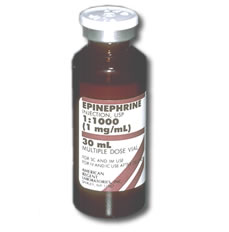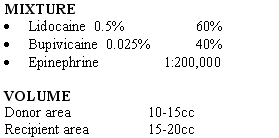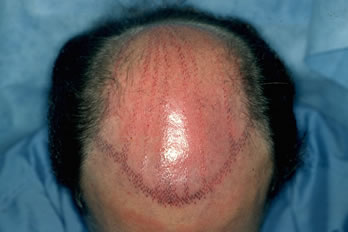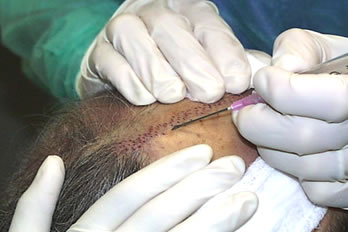Robert M. Bernstein, M.D., New York, NY and William R. Rassman, M.D., Los Angeles, CA
Hair Transplant Forum International 2000; 10(2): 39-42.
Epinephrine (adrenaline) is the body’s most potent stimulant of the sympathetic nervous system. Through its action on alpha and beta-adrenergic receptors, its effects include increased heart rate and force of contraction, elevation of blood pressure, relaxation of bronchiolar and intestinal smooth muscle, glycogenolysis, lipolysis and increased oxygen demand.
When used as a drug, epinephrine can cause fear, anxiety, restlessness, pounding headaches, tremors, weakness, respiratory difficulty and palpitations.
More serious reactions, including cardiac arrhythmias, have been reported.1 In addition; adrenaline can cause drug interactions with a number of commonly used medications, most notably beta-blockers.
The Trend
Epinephrine is extremely useful in hair restoration surgery, especially for long hair transplant sessions. When combined with local anesthetics, its vasoconstrictive properties significantly increases the duration of action of the anesthetic, decreases the total amount needed and increases the maximum amount that can safely be used. Specifically, adrenaline increases the duration of action of Lidocaine from 2 to 6 2/3 hours and Bupivicaine from 4 to 8 hours. By limiting the systemic absorption of the local anesthetic, epinephrine increases the maximum safe dose of Lidocaine from 300mg to 500mg and Bupivicaine from 175mg to 225mg.2
The vasoconstrictive properties of Adrenaline also allow it to significantly decrease intra-operative bleeding. With large hair transplant sessions, hemostasis is particularly important because bleeding decreases visibility during site creation and graft placement, which contributes to graft popping. Because of the “convenience” of epinephrine as an effective hemostatic agent, hair transplant surgeons performing large sessions have resorted to using increasingly higher concentrations in increasingly greater volumes.

Figure 1. Epinephrine
This trend can be exemplified by “Super juice” a term coined to describe concentrations of epinephrine in the range of 1:25,000 (this is 800% greater than the concentration of epinephrine generally used to enhance the action of local anesthetics) that is infiltrated directly into the recipient area to control bleeding. “Piggybacking,” a technique whereby additional quantities of epinephrine are injected into the skin before the previous dose wears off, has also been employed to maximize the vasoconstrictive effects.
The Problem
In contrast to its exquisite ability to enhance the anesthetic properties of local anesthetics, the usefulness of epinephrine in providing hemostasis in long transplant sessions is surprisingly limited. The reason is that its duration of action in the scalp when providing local hemostasis is only about 20 minutes. In addition, epinephrine exhibits “tachyphalaxis” a term describing the phenomena of decreasing efficacy with repeated doses.
There are also hypothetical problems with using epinephrine in large transplant sessions. One is that when the drug is infiltrated into the scalp over large areas, it may predispose to post-operative telogen effluvium (shedding). Another, potentially more serious problem, is that when adrenaline is added to an area whose blood supply is already compromised by a large number of recipient sites, the tissue may not receive enough oxygen. Although not proven, it is likely that epinephrine infiltration into the recipient area is a contributing factor in the development of the “central necrosis” that has occasionally been reported during hair transplantation. It is also possible that the intense vasoconstrictive action of epinephrine may contribute to decreased graft survival.
The Solution
Considering the great value in adding modest amounts of epinephrine to the anesthetic mixture, the limitations that it has in providing hemostasis during long transplant sessions, and the possible toxicity associated with its use, it would seem prudent to use epinephrine for the purpose of establishing anesthesia for the transplant and using other modalities to control intra-operative bleeding. The following simple techniques can be used in achieving this goal:
Perform a Thorough Pre-op Evaluation
An adequate pre-operative evaluation is essential in insuring that there will be no “surprises” during, or after, the procedure. Bleeding tendencies are best elicited by supplementing the verbal history with a printed questionnaire. Unlike hemophilia, that is obvious during childhood, more subtle coagulopathies, such as Von Willebrand’s Disease, may have no manifestations other than easy bruising, and may go undiagnosed well into adult life. A laboratory evaluation consisting of a CBC, Platelet count, Chem screen, PT and PTT should be considered in those with a positive personal or family history or those that are at a higher risk of bleeding, such as heavy drinkers.
Discontinue Predisposing Agents in Advance
It is well known that certain commonly used drugs such as non-steroidal anti –inflammatory agents, alcohol ingestion and certain vitamins may predispose to bleeding. However patients are rarely told to discontinue these agents far enough in advance of their procedure for there to be an effect. For example, aspirin causes acetylation of platelet cyclo-oxygenase, resulting in decreased aggregation and prolongation of the bleeding time, even at very low doses. Because this effect is irreversible, time must pass for a new population of platelets to be produced by the bone marrow. As such, salicylates should be discontinued at least one week prior to the transplant, to minimize its affects on hemostasis.
Control Blood Pressure
Markedly elevated blood pressure is a relative contra-indication for hair transplant surgery, but a seemingly normotensive patient may become hypertension during a transplant for a host of reasons including anxiety, fluid overload, sensitivity to epinephrine and drug interactions. Increased bleeding during the course of the procedure should alert the physician to elevated blood pressure. Preferably, periodic BP readings with a sphygmomanometer, or continuous monitoring with a pulse oximeter, will identify this problem and allow for early intervention.
Use Gravity to One’s Advantage
Placing patients in a sitting position during surgery markedly decreases blood flow to the scalp and is probably the single most important (and easiest) way to control bleeding. Occasionally, patients have a vaso-vagal reaction during the initial administration of local anesthetics and this may occasionally lead to a petit-mal seizure, so caution should be exercised during this time. For patients who are predisposed to fainting, the donor ring block should be administered with the patient lying flat on his/her side.
The recipient ring block can be administered with the patient in a gentle reclining position. Lying flat in this case will cause more discomfort from the injection due to the increased vascularity of the forehead in this position.
When making recipient sites, one should position the patient so that gravity always moves blood away from the operator’s visual field. When designing the frontal hairline, sites should be created from back to front with the patient tilted slightly backward (in the sitting position). The remainder of the sites in the front, mid-scalp and crown can be made front to back, with the head tilted slightly forward.
Avoid High Intensity OR Lights
Incandescent or Halogen lighting generates a significant amount of heat that, in turn, causes the grafts, awaiting placement, to warm and dry out. The lighting also increases blood flow to the scalp resulting in excessive bleeding, decreased visibility and more rapid metabolism of the local anesthetic.
Florescent ceiling lights generate very little heat. If spaced approximately one 2-foot bulb per 6 sq. ft. (four panels of four 2-foot long bulbs in a 100 sq. ft. operating room), they will provide enough light so that supplemental OR lights will not be needed once the donor strip is removed.
Administer Ring-Block Anesthesia
The most efficient way to anesthetize the scalp for a hair transplant is through a ring block or a combination of ring and nerve blocks. Using local infiltration to establish anesthesia is a waste of time and anesthetic. When used as a block, we find the following mixture to be adequate for most hair transplant sessions. More importantly, these doses fall within only a fraction of the maximum safe dose of Lidocaine and Bupivicaine.
Table 1. Ring Block Mixture

When administering the recipient ring block, it is important to “peau-d’ orange” the frontal area (the region between the pupils) as the sensory nerves run very superficial in this location. By using a superficial injection in this location both local anesthetic and epinephrine may be conserved.
Use Tumescence
In addition to providing hemostasis, using tumescence in the donor area, just prior to the harvest, is useful to stabilize the donor tissue, to increase the distance from the base of the hair follicles to the nerves and blood vessels lying in the deep fat (to provide a superficial plane of dissection). It also helps to ensure that the ring-block anesthesia is complete (especially when there is donor scarring from previous procedures). A simple tumescent mixture can be achieved by diluting a bottle of Lidocaine 0.05%, epinephrine 1:200,000 with normal saline, either 3:1 or 5:1.
Table 2. Tumescent Mixture

Tumescence in the recipient area can be useful to help limit the depth of the donor sites, as well as, providing hemostasis. Effective recipient tumescence can be achieved with 1:1,000,000 epinephrine in NS without anesthetic. Recipient tumescence is more useful when all of the sites are pre-made, so the volume of fluid doesn’t cause graft popping and the duration of time the tumescence is needed is limited.
Pre-make Recipient Sites
With the “stick and place” method, epinephrine is used to decrease bleeding, decrease graft popping and increase visibility. Pre-making all the recipient sites prior to graft insertion (rather than using a “stick and place” technique) provides a solution to these problems without the use of epinephrine. First, it initiates the “extrinsic pathway” so that coagulation can begin well before the grafts are introduced. Second, it allows easy cleaning of the recipient area of any blood or coagulum, without the risk of dislodging grafts. Third, the close placement of sites can be achieved without a concern for grafts adjacent to the site popping from the “puncture pressure,” since grafts are not introduced until all (or the majority) of the sites are made.
The logistics of matching the number of sites to the number of grafts can easily be solved by making “projections” of the anticipated number of grafts before the strip is totally dissected. With experience, it is relatively easy to estimate final graft counts within 5%.3
Scatter Sites to Initiate Coagulation

Photo 1. Scattered Recipient Sites
When recipient sites are created in a contiguous fashion, each needle stick creates a fresh bleed that decreases visibility in adjacent areas. If the initial sites are scattered, each site can be made in a blood free zone. The initial sites tend to cause the entire vasculature of the scalp to “clamp down,” creating excellent visibility for subsequent passes and allowing the skipped areas to easily be filled in. Although scattering the sites initiates coagulation and significantly decreases bleeding, one never sees the intense vasoconstriction (manifested by blanching) than occurs when using epinephrine.
Take a Break When Visibility Decreases
There is the temptation to rush to finish making sites in order to “get on with the next case.” However, taking short breaks every 100-200 sites allows the coagulation pathways to work and gives time for the staff to clean the recipient area. This will permit site placement to be made far more accurately and eliminate the risk of one site merging with another (and result in a slit large enough to leave a scar). When the staff is of sufficient size and the physical facilities permit, it may be advantageous to transplant two patients in parallel, so that the surgeon can alternate between patients and is literally “forced” to slow down and let the staff and “nature” help out.
Apply Bimanual Traction
Bleeding can easily be controlled by stretching the skin in the area where sites are being made. If extra staff is available while making sites, the surgeon can stretch the skin toward him with his free hand, and the assistant can use one hand to stretch in the opposite direction and use his/her free hand to ballot. When the surgeon works alone, the sites can be made in the skin stretched between the 3rd and 4th fingers and the thumb. Stretching also decreases bleeding by elevating the skin away from the deeper vessels and keeping the puncture wounds more superficial.

Photo 2. Skin Stretch Technique
Keep Recipient Sites Small and Superficial
It goes without saying that small recipient sites will cause less injury to blood vessels and therefore less bleeding. Recently, the importance of keeping wounds superficial has been emphasized by Dr. James Arnold.4 The Mindi-Knife has been specifically designed to accomplish these goals and this and other instruments that minimize wounding will permit the use of less epinephrine.
Creating a “Snug Fit”
Sizing the size to fit securely around a pre-cut graft will allow the graft to act efficiently to tamponade bleeding. In addition, by eliminating the formation of a micro-coagulum and promoting contact between the wall of the recipient site and the graft, oxygenation is most likely facilitated. We find that sites sizes that range in size from 1.1mm to 1.75mm are ideal to produce a “snug fit” around follicular units of 1-4 hairs, even in African hair types.
Keep the Patient’s Headband Loose
Besides, being uncomfortable for the patient, a tight headband will decrease venous return and increase venous engorgement of the scalp. Attention to this problem can easily eliminate this as a source of increased bleeding.
Smoke
Nicotine is a potent vasoconstrictor. Patients who are chronic smokers, and who completely stop smoking preoperatively, are often found to bleed excessively during the procedure, possibly due to reactive vaso-dilatation. Rather than attempting to control the bleeding with additional epinephrine, we occasionally have the patient smoke part of a cigarette, mid-surgery, and the problem is often solved.
Keep Cool
Last, but not least, keep cool! Decreasing the temperature of the operating room to the lowest comfortable level appears to decrease bleeding in the scalp (although the blood vessels in the scalp do not appear to actively vasoconstrict in response to cold as much as other “acral” areas of the body). We have occasionally applied cold compresses to the scalp in order to promote vasoconstriction, but now rarely find this necessary.
Conclusion
The use of large amounts of epinephrine for the purpose of establishing hemostasis in large hair transplant sessions is neither necessary, nor desirable. Because intra-operative bleeding in the recipient during site creation and graft placement can be controlled by simple methods, that are easy to administer and free from adverse affects, the reliance upon epinephrine in these phases of the procedure should be reconsidered.
References
1. Goodman AG, Gillman LS. The Pharmacological Basis of Therapeutics, 7th ed. New York: Macmillan Publishing, 1985:151-59.
2. Skidmore RA, Patterson JD, Tomsick, RS: Local anesthetics. Dermatol Surg 1996; 22:511-522.
3. Bernstein RM, Rassman WR, Szaniawski W, Halperin A: Follicular Transplantation. Int J of Aesthetic and Rest Surg 1995; 3: 119-132.
4. Arnold J: Mini-blades and a Mini-blade Handle for Hair Transplantation. Am J Cosm Surg 1997; 14(2): 195-200.




